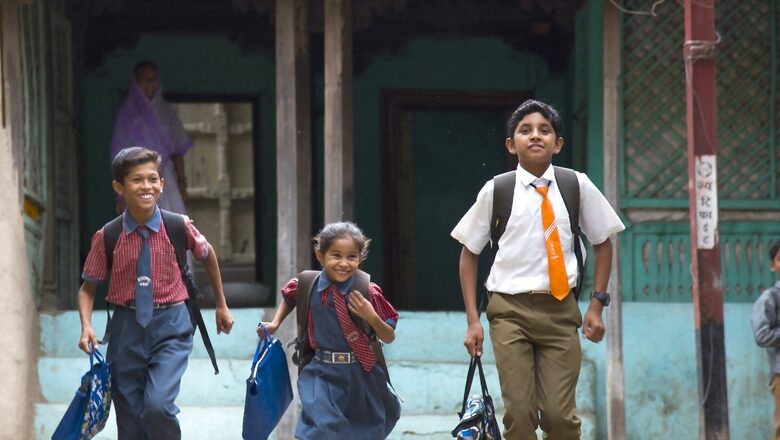
views
Panic among parents, underlying health conditions or incidental coronavirus infection – these are the top reasons behind the admission of children in hospitals due to Covid-19, paediatricians across India told News18.com. While the doctors haven’t seen any increase in the hospitalisation among children in the ongoing third wave caused by heavily mutated variant Omicron, they are expecting a few cases of multisystem inflammatory syndrome in children (MIS-C) – a rare but possible side effect of Covid – by mid-February or March.
More than half a dozen medical child health experts News18.com spoke to confirmed that children – in all the three waves – have only reported “mild Covid-19” disease and recover “within one week”.
“This time, Covid doesn’t appear to be causative but is rather incidental in children getting admitted to Paediatric Intensive Care Unit (PICU),” said Dr Maninder Singh Dhaliwal, associate director, paediatrics, Medanta.
It means that children are not admitted in ICUs or in hospitals because of Covid per se but they are admitted due to some other conditions such as cancer, liver or heart disease and have also incidentally tested positive for coronavirus.
“Majority of children get mild Covid-19 disease, which recovers on its own within a week or less. However, if the child is not behaving as usual, it is necessary to connect with the doctor early and not self-medicate” Dhaliwal added.
However, the pandemic is causing increased outpatient department (OPD) visits due to fever, cough and vomiting.
Around 90% of the cases of Covid-19 among children arrive at the OPD and do not require hospitalisation, say experts.
According to Dr Somashekhar Nimbalkar, a neonatologist and associate dean of research services at the Pramukhswami Medical College in Karamsad, Gujarat, the admissions in hospitals due to Covid among children were already low and “now in the Omicron wave, the admissions are even lower than before. Most of the children only have a sore throat and fever.”
MIS-C was seen in both waves but neonatal MIS-C was recorded in the second wave, he said. “So far, there are no reports of the syndrome in South Africa and the UK. Hopefully, most pregnant mothers are vaccinated and we will have to see if neonatal MIS-C does happen.”
According to the analysis of the ministry of health and family welfare, in the age group of 11 to 18 years, fever is the most common symptom along with upper respiratory tract infection.
The government data shows that in the second wave, approximately 12% of the Covid-infected population was contributed by patients less than 20 years of age. However, there is not much data to show the present or overall trend of Covid illness among children.
Why and how Covid impacts children
According to a webinar by the All India Institute of Medical Sciences (AIIMS)’s paediatrics department, the aerosol mode is the primary channel responsible for causing infection among children.
While fever and cough remain the most common symptoms of Covid-19, the list of atypical symptoms include gastrointestinal issues. Seen in around 5-10% of cases, at AIIMS, the top symptoms are diarrhoea, vomiting and abdominal pain.
The presentation at the webinar, which took place on January 13, showed that the ACE-2 receptors in children – the cells through which the coronavirus enters the human body – are “less expressed”, making the entry difficult.
Also, their innate immunity is strong apart from the absence of any comorbidity such as diabetes, cardiovascular disease or hypertension (like in elders), which makes them fitter and stronger.
Additionally, children don’t have harmful habits such as smoking, alcohol consumption among others followed by an excellent regeneration capacity of paediatric alveolar epithelium – the thin lining of the lungs.
The webinar addressed the trend of increasing hospitalisation among children in the United States.
Nearly 1 million cases of Covid-19 were reported among kids in the US last week, the American Academy of Pediatrics had announced.
However, the panel of experts at the webinar concluded that no such trend has been reported in India, so far. “Omicron gives mild disease. We must curtail the panic among parents,” Dr Ashok Deorari, head of department, paediatrics, at AIIMS, said in the webinar.
What should parents look for?
According to the paediatricians, parents should monitor the fever and activity of the child along with the pattern of breathing and oxygen levels.
They must keep the child hydrated and record the persistence of fever. If the child is breathing fast or shallow, not interacting and the lips are turning blue, he or she should be immediately taken to the hospital.
According to Dr Krishan Chugh, head of the department, paediatrics, Fortis Memorial Hospital, Gurugram, “In some cases, where fever is high and the child is unable to take the medicine or vomits it out repeatedly, the treating doctor can take a call and admit the child to daycare. The child can be given a glucose drip and intravenous vomiting medicine dose.”
However, there is no greater need for hospitalisation unless the child has a history of other medical conditions. “Till now, there is no proof that Covid-19 works the same way in children as it does in adults,” he said.
Among infants aged 0-6 months, the parents should try to prevent fever from exceeding 102 degrees Fahrenheit, said Dr Chugh.
“High fever can cause febrile seizures among children. Hence, one should prevent high fever by administering anti-fever medicines on time. Sponging can also be done using normal lukewarm water,” he said.
Dr Chugh advised that the right way to check the oxygen saturation parameter of children below 5 years of age is to use the device on a child’s hallux (big toe of the foot) or the thumb when he or she is sleeping.
“Also, we must ensure that there is no layer of nail polish when we check SpO2,” he added.
Other doctors echoed similar observations.
“Any viral infection including Covid may cause high-grade fever for 2-3 days in some children. Especially in the younger ones, high-grade fever not decreasing with oral medications may cause a febrile seizure. This seems to be one of the main reasons for Covid-related admissions,” Dr Dhaliwal from Medanta said.
He also advised that parents tend to add multiple layers of clothes when a child is running a high fever, which may worsen the temperature or make the patient more irritable. “It is important to just keep the child comfortable and avoid excessive layers of clothes to allow better heat dissipation and ease the fever.”
Doctors clarified that drugs including azithromycin, vitamin C and ivermectin have no role in the treatment of Covid-19 among children.
Dr M Narayanan, a paediatrician and former president, Indian Medical Association, Cochin branch, said there is no special drug that has been approved for the treatment of children, hence, only symptomatic treatment is given.
“Such as cough syrup for cough or nebuliser for asthma…Sometimes, parents are in grave panic and they insist on writing drugs or may self-prescribe. In such cases, vitamin C or vitamin D3 can be given but they have a placebo effect on treating Covid-19.” Placebo effect is when the brain can convince the body that a fake treatment is the real thing and cause healing.
The only therapy that works in the treatment of children, according to the medical experts, is hydration, paracetamol, sponging and a healthy diet.
Rare but possible deregulation of immune system
Multisystem inflammatory syndrome in children (MIS-C) is a serious condition, which is to be linked to Covid-19.
Children become infected with the mild coronavirus but some develop MIS-C – on average after 6 weeks of catching the infection – where some organs and tissues of the body such as heart, lungs, blood vessels, kidneys, digestive system, brain, skin or eyes become inflamed.
The reason is deregulation of the immune system of the body. “If Omicron also causes MIS-C, we can expect some cases by mid-February,” Dr Narayanan said.
Here, the inflammatory markers are high and the classic symptoms are fever and rashes. MIS-C is primarily noticed among children from 0-7 years of age.
“On spotting such symptoms, we find the retrospective evidence of Covid and antibody tests or parents confirm that the child had a bout of Covid some weeks ago,” Dr Narayanan added.
In this case, steroids are being administered to children as per the guidelines issued by the ministry of health.
“Till now, management of Omicron is the same as managing the Delta-driven Covid wave. But we need to keep a watch on whether due to Omicron, MIS-C cases have remained the same or increased. Data collation, follow-up with children and sharing the data will help win this battle,” Dr Deorari from AIIMS said.
Read all the Latest India News here



















Comments
0 comment